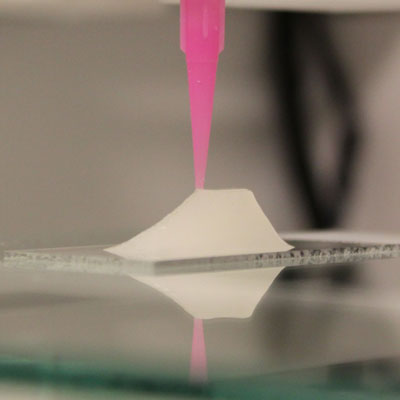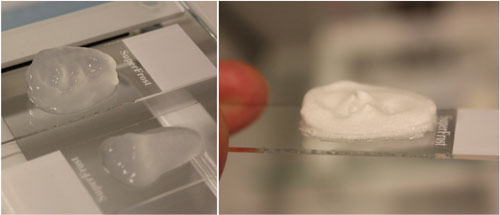| Posted: Feb 22, 2018 | |
Why burn bagasse when you can 3D print its nanocellulose |
|
| (Nanowerk Spotlight) Bagasse is a waste plant matter obtained by food industry processes such as beer brewing, plant oil extraction or sugarcane processing for production of bioplastic. It is an underutilized agro-industrial residue that often gets incinerated to produce heat and electricity or used to make fodder. | |
| However, as new research shows, bagasse has great potential as raw material for the production of cellulose nanofibrils (CNF) for a range of applications (ACS Sustainable Chemistry & Engineering, "Pulping and pretreatment affect the characteristics of bagasse inks for 3D printing"). | |
| Researchers from Norway, Argentina and Sweden have developed a CNF ink from bagasse that has potential as component in bioinks for 3D printing. Bioinks are inks that contain living cells and that can be 3D printed in a cell-friendly manner, without compromising cell viability. | |
| Cellulose nanofibrils are of great interest for the design and manufacture of nanopaper, nanocomposite materials, and even biomedical applications (read more: "Nanotechnology in the pulp and paper industry"). Typically having lengths in the micrometer scale and widths in the nanometer scale (<20 nm), the morphology and surface chemistry of CNF can be tailored by different chemical and enzymatic pretreatments and processing steps. | |
| "Bagasse pulp has proven to be a suitable raw material for cellulose nanofibril production, and the properties of the CNFs are analogous to those of CNF produced from wood pulps," Gary Chinga-Carrasco, a senior research scientist at RISE-PFI in Norway, tells Nanowerk. "However, so far the effect of a given pulping method and the chemical composition of the produced pulp fibers on the corresponding CNF for 3D-printable inks has not been assessed yet." | |
| In this new work by the RISE PFI team, they studied the suitability of bagasse for the production of CNF inks for 3D printing, and how some properties of the inks differed when using bagasse pulps with different characteristics. | |
 |
|
| 3D printing of a nanocellulose construct. (Image: Gary Chinga Carrasco, RISE PFI AS) | |
| To that end, they first obtained pulp fibers from the bagasse raw material using two fractionation methods, i.e. soda, and hydrothermal treatment combined with soda. In a second step, the pulp fibers were pre-treated by two levels of TEMPO-mediated oxidation before CNF production by homogenization. | |
| Finally, the resulting CNFs were characterized in detail – morphology, surface chemistry, cytotoxicity – and assessed as inks for 3D printing. Especially nanocellulose for biomedical applications requires a thorough assessment in order to secure its biocompatibility with the human body and its use in biomedical devices such as wound dressings. | |
| "The pulping process is important to design inks for 3D printing, having appropriate surface chemistry, chemical composition and nanofibrillar morphology," Chinga Carrasco points out. "This is an aspect that has not been considered before in the design and formulation of inks for 3D bioprinting." | |
| "The inks have potential in 3D printing and may be used for structuring biomedical devices, e.g. wound dressings and scaffolds for drug testing," he adds. "The non-cytotoxic materials assessed in this study seem to be good candidates for such applications." | |
 |
|
| 3D printed ears and nose with bagasse nanocellulose inks. (Image: Gary Chinga Carrasco, RISE PFI AS) (click on image to enlarge) | |
| To demonstrate the capabilities of their ink, the researchers printed 3D models of ears and noses, which shows the potential of the material to 3D print constructs from an agro-industrial residue. | |
| The researchers will continue work on optimizing the pulping process in order to obtain an ink that provides optimal print quality without compromising its biocompatibility. | |
 By
Michael
Berger
– Michael is author of three books by the Royal Society of Chemistry:
Nano-Society: Pushing the Boundaries of Technology,
Nanotechnology: The Future is Tiny, and
Nanoengineering: The Skills and Tools Making Technology Invisible
Copyright ©
Nanowerk LLC
By
Michael
Berger
– Michael is author of three books by the Royal Society of Chemistry:
Nano-Society: Pushing the Boundaries of Technology,
Nanotechnology: The Future is Tiny, and
Nanoengineering: The Skills and Tools Making Technology Invisible
Copyright ©
Nanowerk LLC
|
|
|
Become a Spotlight guest author! Join our large and growing group of guest contributors. Have you just published a scientific paper or have other exciting developments to share with the nanotechnology community? Here is how to publish on nanowerk.com. |
|
